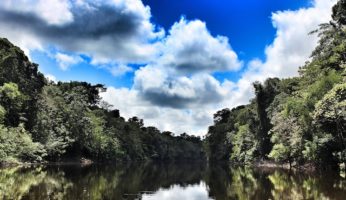
By Maria Russo
I stood holding the spindly wooden stick with a firm grasp as the voracious predator in the black waters below me mauled the bloody chunk of bait affixed to my hook. Out in the distance, pink dolphins danced and weaved through the river’s current as Ringed Kingfishers sailed from one vine to the next along the muddy bank.
I fixed my attention back on my stick, bobbing the line to draw attention to the meat. I felt a furry of jabs and then a strong bite as I hurled the line from the water. The piranha thrashed its silvery-red body about as I passed him over to our guide Victor. “Dinner,” he said with a long smile as he unhooked the fish and placed it in ice.
It was the fifth day of a cruise along the Amazon River Basin on the Queen Violeta, a 32-passenger riverboat. The cruise was part of a nine-day excursion led by Canadian travel and tour company G Adventures.
Our group of 15 travelers met in Lima where we rested and recuperated from long international flights. We then flew to Iquitos, the largest city in the Peruvian rainforest to begin our journey.
I was unsure of what to expect of Iquitos being that it is literally isolated from the rest of the world with not a single road leading in or out (with the exception of a road to Nauta, a small town roughly 100 km south). But this city was similar to any other in the developing world: a vibrant bustling market; streets choked with used cars and auto rickshaws, or motokars as they are known in Iquitos; hustlers and vendors selling kitschy items on most corners; and the sent of burning sweet wood permeating from homes and stalls throughout.
Our group, led by tour guides Victor and Rudy, visited the city’s largest market, which serves as a main hub for business and the local food supply. On display were staple foods such as yucca, plantains, farina and tapioca and delicacies like turtle eggs, salted fish from the Amazon and suri, maggot-like insects that are the grubs of palm beetles. A variety of pure medicinal herbs from the rainforest were also on offer, and had I known at the time that it would be virtually impossible to order any of these plant extracts in their raw form from the U.S., I would have purchased a few bottles before leaving.
Just beyond the market was Belen, a shantytown consisting of 65,000 inhabitants most of whom live in extreme poverty. The district lies in the floodplain of the Itaya River, so all homes are built on stilts to ensure that they are not washed away when the river swells during the rainy season. It was humbling to witness this spirit of determination to survive and thrive among the most dire circumstances. The memory of Belen will remain with me as a reminder that travel is our greatest teacher.
We would return again to Iquitos at the very end of our journey to visit a manatee rehabilitation center where we learned about programs that are being implemented to educate Peruvians on the importance of protecting their precious wildlife…
